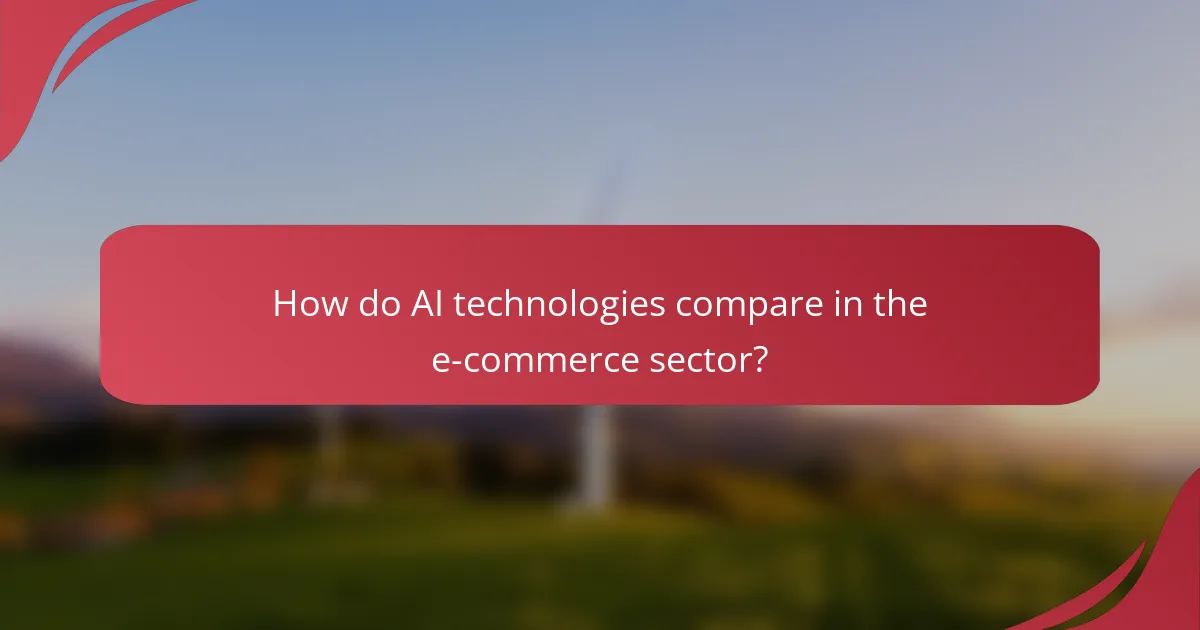The impact of AI on e-commerce is profound, as it drives innovation and enhances operational efficiency through advanced technologies. With strategic funding, businesses can leverage AI to automate processes, optimize inventory, and elevate customer experiences, positioning themselves competitively in the market. By exploring diverse funding avenues, such as crowdfunding and angel investments, e-commerce companies can unlock new growth opportunities and foster continuous innovation.

How is AI funding transforming e-commerce?
AI funding is significantly reshaping e-commerce by enabling innovative solutions that enhance customer experiences and streamline operations. Increased financial backing allows businesses to adopt advanced technologies, leading to improved efficiency and competitiveness in the market.
Increased investment in AI startups
The surge in investment for AI startups is driving the development of cutting-edge tools tailored for e-commerce. These startups are often focused on areas such as predictive analytics, personalized marketing, and inventory management, which can lead to substantial cost savings and revenue growth.
Investors are particularly interested in startups that demonstrate clear use cases and potential for scalability. For e-commerce businesses, partnering with these startups can provide access to innovative solutions that enhance operational efficiency and customer engagement.
Partnerships with venture capital firms
Collaborations between e-commerce companies and venture capital firms are becoming increasingly common as firms seek to capitalize on the AI trend. These partnerships often provide not only funding but also strategic guidance, helping e-commerce businesses navigate the complexities of AI implementation.
Through these alliances, companies can gain insights into market trends and access a network of resources that can accelerate their growth. It’s essential for e-commerce businesses to choose partners that align with their vision and can offer expertise in AI technologies.
Government grants for AI research
Government grants for AI research are a vital source of funding for e-commerce initiatives aimed at innovation. Many countries offer financial support to businesses that are developing AI technologies, which can significantly reduce the financial burden of research and development.
Applying for these grants often requires a clear demonstration of how the proposed AI solutions will benefit the economy or society. E-commerce companies should stay informed about available grants and consider how their projects align with government priorities to enhance their chances of securing funding.

What are effective AI funding strategies for e-commerce?
Effective AI funding strategies for e-commerce include leveraging crowdfunding platforms, attracting angel investors, and engaging with corporate venture capital initiatives. Each method offers unique advantages and considerations that can significantly impact the growth and innovation of e-commerce businesses.
Crowdfunding platforms like Kickstarter
Crowdfunding platforms such as Kickstarter provide a way for e-commerce businesses to raise capital directly from consumers. This strategy allows entrepreneurs to showcase their AI-driven products and gauge market interest before full-scale production.
When using crowdfunding, it’s crucial to create a compelling campaign that highlights the unique benefits of your AI solution. Successful campaigns often feature engaging videos, clear funding goals, and attractive rewards for backers. Aim for funding targets in the low tens of thousands of USD to effectively launch a project.
Angel investors focused on technology
Angel investors who specialize in technology can provide not only funding but also valuable mentorship and industry connections. These investors typically look for innovative e-commerce solutions that leverage AI to enhance customer experience or streamline operations.
To attract angel investors, prepare a solid business plan that outlines your AI strategy, market potential, and financial projections. Networking at tech meetups or startup events can help you connect with potential investors. Keep in mind that angel investments often range from tens of thousands to a few hundred thousand USD.
Corporate venture capital initiatives
Corporate venture capital (CVC) initiatives involve established companies investing in startups to foster innovation and gain access to new technologies. For e-commerce businesses, partnering with a CVC can provide not only funding but also strategic support and resources.
When seeking CVC funding, target corporations that align with your business model and AI applications. Prepare to demonstrate how your technology can enhance their existing operations or product offerings. CVC investments can vary widely, often starting from hundreds of thousands to several million USD, depending on the strategic fit and potential impact.

How does AI improve operational efficiency in e-commerce?
AI enhances operational efficiency in e-commerce by automating repetitive tasks, optimizing inventory, and improving customer interactions. This leads to reduced costs, faster processes, and better decision-making, ultimately driving sales and customer satisfaction.
Automated inventory management systems
Automated inventory management systems leverage AI to track stock levels, predict demand, and manage reordering processes. By analyzing sales patterns and trends, these systems can minimize overstock and stockouts, ensuring that products are available when customers want them.
For effective implementation, businesses should integrate these systems with existing e-commerce platforms. Regularly updating inventory data and using alerts for low stock can prevent disruptions in sales and improve cash flow.
AI-driven customer service chatbots
AI-driven customer service chatbots provide instant responses to customer inquiries, significantly improving response times and customer satisfaction. These chatbots can handle a variety of tasks, from answering FAQs to assisting with order tracking, freeing up human agents for more complex issues.
To maximize their effectiveness, businesses should ensure chatbots are trained on relevant data and continuously updated. Providing an easy transition to human support when needed can enhance the overall customer experience.
Predictive analytics for sales forecasting
Predictive analytics uses AI to analyze historical sales data and forecast future trends, helping e-commerce businesses make informed inventory and marketing decisions. By understanding customer behavior and market dynamics, companies can tailor their strategies to meet demand effectively.
Implementing predictive analytics involves collecting accurate data and utilizing machine learning algorithms to identify patterns. Regularly reviewing forecasts against actual sales can refine the accuracy of predictions and improve business agility.

What innovations are driven by AI in e-commerce?
AI is transforming e-commerce through innovations that enhance customer engagement, optimize pricing strategies, and improve product visualization. These advancements not only streamline operations but also create more personalized shopping experiences for consumers.
Personalized shopping experiences
AI enables e-commerce platforms to deliver personalized shopping experiences by analyzing customer data and behavior. This technology can recommend products based on previous purchases, browsing history, and even social media activity.
For instance, algorithms can segment users into different profiles, allowing retailers to tailor marketing messages and promotions to specific groups. This targeted approach can significantly increase conversion rates and customer satisfaction.
Dynamic pricing algorithms
Dynamic pricing algorithms leverage AI to adjust prices in real-time based on market demand, competitor pricing, and inventory levels. This strategy helps retailers maximize profits while remaining competitive in a fast-paced market.
For example, an online retailer might lower prices during off-peak hours or increase them during high-demand periods. However, businesses should be cautious of consumer perceptions; frequent price changes can lead to distrust if not managed transparently.
Augmented reality for product visualization
Augmented reality (AR) enhances product visualization by allowing customers to see how items would look in their own environment before making a purchase. This technology is particularly useful in sectors like furniture and fashion, where fit and aesthetics are crucial.
Retailers can implement AR features through mobile apps or websites, enabling users to virtually “try on” products. This not only improves the shopping experience but can also reduce return rates, as customers have a clearer understanding of what they are buying.

What criteria should businesses consider for AI adoption?
Businesses should evaluate several key criteria for AI adoption, including cost-benefit analysis, scalability, and integration with existing systems. These factors help determine whether AI solutions will enhance operational efficiency and drive innovation.
Cost-benefit analysis of AI tools
A thorough cost-benefit analysis is essential when considering AI tools. This involves assessing the initial investment against potential savings and revenue increases. For example, if an AI system can reduce operational costs by 20% while costing 15% of current expenses, it may be a viable option.
Consider both direct costs, such as software and hardware, and indirect costs, like training and maintenance. It’s also important to factor in the potential for increased productivity and customer satisfaction, which can lead to higher profits.
Scalability of AI solutions
Scalability refers to the ability of AI solutions to grow with your business needs. When selecting AI tools, ensure they can handle increased data loads and user demands without significant additional costs. Solutions that offer modular features or cloud-based scalability are often preferable.
For instance, a small business may start with a basic AI tool for customer service, but as it grows, it should be able to expand its capabilities to include advanced analytics or personalized marketing without needing to overhaul the entire system.
Integration with existing systems
Successful AI adoption hinges on how well new tools integrate with existing systems. Evaluate whether the AI solution can seamlessly connect with current software and hardware to avoid disruptions. Compatibility issues can lead to increased costs and delays.
Conduct a thorough assessment of your current infrastructure and identify any potential gaps. Look for AI solutions that offer APIs or other integration options to facilitate a smooth transition. This will help ensure that your investment in AI enhances rather than complicates your operations.

How do AI technologies compare in the e-commerce sector?
AI technologies significantly enhance the e-commerce sector by improving customer experience, optimizing operations, and driving innovation. Key areas of comparison include personalization, inventory management, and customer service automation.
Personalization and Customer Experience
AI technologies enable e-commerce businesses to deliver personalized shopping experiences by analyzing customer data and behavior. This can lead to tailored product recommendations, targeted marketing campaigns, and customized pricing strategies. For example, platforms like Amazon use AI algorithms to suggest products based on previous purchases, which can increase conversion rates.
To effectively implement personalization, businesses should focus on collecting and analyzing customer data while ensuring compliance with data protection regulations. Utilizing machine learning models can help predict customer preferences and enhance engagement.
Inventory Management Efficiency
AI can optimize inventory management by predicting demand and automating stock replenishment. This reduces the risk of overstocking or stockouts, which can be costly for e-commerce retailers. For instance, AI systems can analyze historical sales data and market trends to forecast future demand accurately.
Companies should consider integrating AI-driven inventory management tools that provide real-time insights and analytics. This can help streamline operations and improve supply chain efficiency, ultimately leading to cost savings.
Customer Service Automation
AI technologies, such as chatbots and virtual assistants, are transforming customer service in e-commerce by providing instant support and resolving queries quickly. These tools can handle a high volume of inquiries, allowing human agents to focus on more complex issues. For example, many retailers use chatbots to assist customers with order tracking and product information.
When implementing customer service automation, businesses should ensure that AI solutions are user-friendly and capable of understanding natural language. Regularly updating the AI with new information and feedback can enhance its effectiveness and customer satisfaction.


